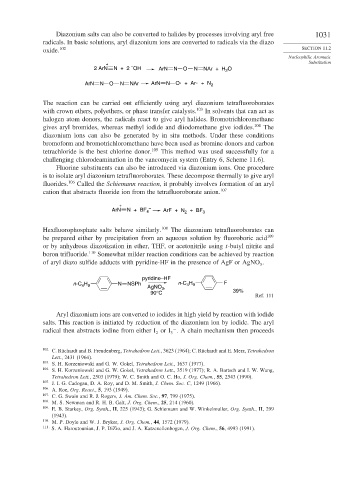Page 1055 - Advanced Organic Chemistry Part B - Reactions & Synthesis
P. 1055
Diazonium salts can also be converted to halides by processes involving aryl free 1031
radicals. In basic solutions, aryl diazonium ions are converted to radicals via the diazo
oxide. 102 SECTION 11.2
Nucleophilic Aromatic
Substitution
+
–
2 ArN N + 2 OH ArN N O N NAr + H O
2
.
.
ArN N O N NAr ArN N O + Ar + N 2
The reaction can be carried out efficiently using aryl diazonium tetrafluoroborates
with crown ethers, polyethers, or phase transfer catalysts. 103 In solvents that can act as
halogen atom donors, the radicals react to give aryl halides. Bromotrichloromethane
gives aryl bromides, whereas methyl iodide and diiodomethane give iodides. 104 The
diazonium ions can also be generated by in situ methods. Under these conditions
bromoform and bromotrichloromethane have been used as bromine donors and carbon
tetrachloride is the best chlorine donor. 105 This method was used successfully for a
challenging chlorodeamination in the vancomycin system (Entry 6, Scheme 11.6).
Fluorine substituents can also be introduced via diazonium ions. One procedure
is to isolate aryl diazonium tetrafluoroborates. These decompose thermally to give aryl
fluorides. 106 Called the Schiemann reaction, it probably involves formation of an aryl
cation that abstracts fluoride ion from the tetrafluoroborate anion. 107
+
ArN N + BF 4 – ArF + N + BF 3
2
Hexfluorophosphate salts behave similarly. 108 The diazonium tetrafluoroborates can
be prepared either by precipitation from an aqueous solution by fluoroboric acid 109
or by anhydrous diazotization in ether, THF, or acetonitrile using t-butyl nitrite and
boron trifluoride. 110 Somewhat milder reaction conditions can be achieved by reaction
of aryl diazo sulfide adducts with pyridine-HF in the presence of AgF or AgNO .
3
pyridine–HF
H
n-C H N NSPh n-C 4 9 F
4 9
AgNO 3 ,
90°C 39%
Ref. 111
Aryl diazonium ions are converted to iodides in high yield by reaction with iodide
salts. This reaction is initiated by reduction of the diazonium ion by iodide. The aryl
−
radical then abstracts iodine from either I or I . A chain mechanism then proceeds
3
2
102 C. Rüchardt and B. Freudenberg, Tetrahedron Lett., 3623 (1964); C. Rüchardt and E. Merz, Tetrahedron
Lett., 2431 (1964).
103
S. H. Korzeniowski and G. W. Gokel, Tetrahedron Lett., 1637 (1977).
104 S. H. Korzeniowski and G. W. Gokel, Tetrahedron Lett., 3519 (1977); R. A. Bartsch and I. W. Wang,
Tetrahedron Lett., 2503 (1979); W. C. Smith and O. C. Ho, J. Org. Chem., 55, 2543 (1990).
105 J. I. G. Cadogan, D. A. Roy, and D. M. Smith, J. Chem. Soc. C, 1249 (1966).
106
A. Roe, Org. React., 5, 193 (1949).
107 C. G. Swain and R. J. Rogers, J. Am. Chem. Soc., 97, 799 (1975).
108
M. S. Newman and R. H. B. Galt, J. Org. Chem., 25, 214 (1960).
109
E. B. Starkey, Org. Synth., II, 225 (1943); G. Schiemann and W. Winkelmuller, Org. Synth., II, 299
(1943).
110 M. P. Doyle and W. J. Bryker, J. Org. Chem., 44, 1572 (1979).
111
S. A. Haroutounian, J. P. DiZio, and J. A. Katzenellenbogen, J. Org. Chem., 56, 4993 (1991).

